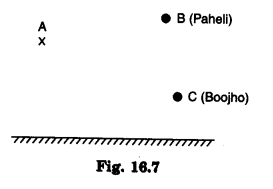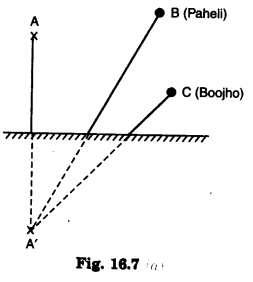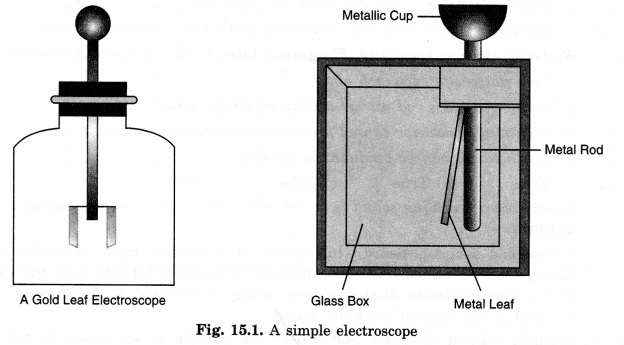NCERT Solutions for Class 8 Science Chapter 11 Force and Pressure are part of NCERT Solutions for Class 8 Science. Here we have given NCERT Solutions for Class 8 Science Chapter 11 Force and Pressure.
| Board | CBSE |
| Textbook | NCERT |
| Class | Class 8 |
| Subject | Science |
| Chapter | Chapter 11 |
| Chapter Name | Force and Pressure |
| Number of Questions Solved | 10 |
| Category | NCERT Solutions |
NCERT Solutions for Class 8 Science Chapter 11 Force and Pressure
NCERT TEXTBOOK EXERCISES
Question 1.
Give two examples of each of situations in which you push or pull to change the state of motion of objects.
Answer.
(1) If a rubber ball or marble is placed on a very smooth surface and given a small push, it starts moving with some speed. If we keep an obstacle in the way of motion of the marble/ball, the marble/ball will stop moving at the obstacle. Here a push is given to the marble/ball at rest to change its state of rest to motion.
(2) If a child is placed on a hanging swing in the state of rest and the swing is pulled again and again by a rope, the swing will move to and fro with a speed. If the pull is bigger, the swing will move at a bigger distance. This is an example of a pull that changed the state of an object from the rest of the motion.
Question 2.
Give two examples of situations in which applied force causes a change in the shape of an object.
Answer.
- If an inflated balloon is taken and pressed from two sides with a hand, its shape changed, i.e., the figure is disturbed. If the inflated balloon is pressed with more force, the balloon will burst.
- If a plate of steel is beaten with a hammer, after four-five big blows the plate’s shape will change.
Question 3.
Fill in the blanks in the following statements:
- To draw water from a well, we have to ……….. at the rope.
- A charged body………….an uncharged body towards it.
- To move a loaded trolley, we have to…………...it.
- The north pole of a magnet…………….the north pole of another magnet.
Answer.
- pull
- attracts
- pull/push
- repels.
Question 4.
An archer stretches her bow while taking aim at the target. She then releases the arrow, which begins to move towards the target. Based on this information fill up the gaps in the following statements using the following terms: muscular, contact, non-contact, gravity, friction, shape, attraction.
- To stretch the bow, the archer applies a force that causes a change in its……..
- The force applied by the archer to stretch the bow is an example of.………..force.
- The type of force responsible for a change in the state of motion of the arrow is an example of a…………….force.
- While the arrow moves towards its target, the forces acting on it are due to……….and that due to of air.
Answer.
- shape
- muscular
- contact
- gravity, friction.
Question 5.
In the following situations identify the agent exerting the force and the object on which it acts. State the effect of the force in each case.
(a) Squeezing a piece of lemon between the fingers to extract its juice.
(b) Taking out paste from a toothpaste tube.
(c) A load suspended from a spring while its other end is on a hook fixed to a wall.
(d) An athlete making a high jump to clear the bar at a certain height.
Answer.
| S. No. | Agent exerting the force | Object on which it acts | Form of effect |
| (a) | Fingers | Lemon as whole | Change in shape |
| (b) | Fingers | Tube as whole | Change in shape |
| (c) | Load | Spring | Change in shape |
| (d) | Athlete | Bar | High jump |
Question 6.
A blacksmith hammers a hot piece of iron while making a tool. How does the force due to hammering affect the piece of iron?
Answer.
The shape of the hot piece of iron changes. It flattens and becomes thinner than earlier. This is the effect of force due to hammering the piece of iron.
Question 7.
An inflated balloon was pressed against a wall after it has been rubbed with a piece of synthetic cloth. It was found that the balloon sticks to the wall. What force might be responsible for the attraction between the balloon and the wall?
Answer.
Electrostatic force.
Question 8.
Name the forces acting on a plastic bucket containing water held above ground level in your hand. Discuss why the forces acting on the bucket do not bring a change in its state of motion.
Answer.
The forces that act on the bucket are as follows:
- The pressure of water contained in it exerted on its wall and on the base of the bucket.
- Force of gravity exerted by earth.
- Muscular force by my hand.
The water is contained in a bucket and the pressure is exerted by water on the walls of the bucket, which is sufficient to take it as a force. This force is counterbalanced by the force exerted by the walls of the bucket on water. As the bucket (with water) is held in my hand, so I overcome the force of gravity of the earth.
Thus, it can be concluded that there is no net effect of forces acting on the bucket full of water. That is why these forces do not bring a change in its state of motion.
Question 9.
A rocket has been fired upwards to launch a satellite in its orbit. Name the two forces acting on the rocket immediately after leaving the launching pad.
Answer.
The two forces that are acting on the rocket immediately after leaving the launching pad are:
- Force of gravity of earth acting down-ward
- The frictional force produced by air particles.
Question 10.
When we press the bulb of a dropper with its nozzle kept in water, the air in the dropper is seen to escape in the form of bubbles. Once we release the pressure on the bulb, water gets filled in the dropper. The rise of water in the dropper is due to
(a) pressure of water
(b) the gravity of the earth
(c) the shape of a rubber bulb
(d) atmospheric pressure
Answer.
(a) the pressure of water.
We hope the NCERT Solutions for Class 8 Science Chapter 11 Force and Pressure help you. If you have any query regarding NCERT Solutions for Class 8 Science Chapter 11 Force and Pressure, drop a comment below and we will get back to you at the earliest.

























